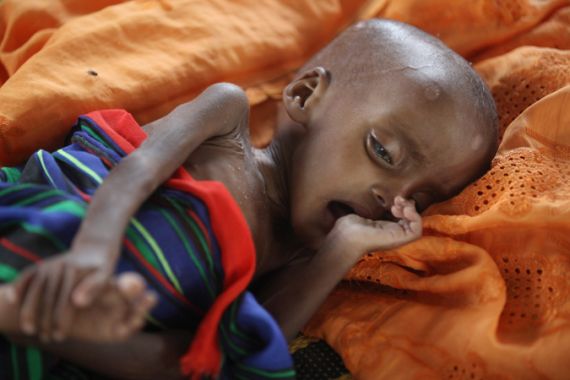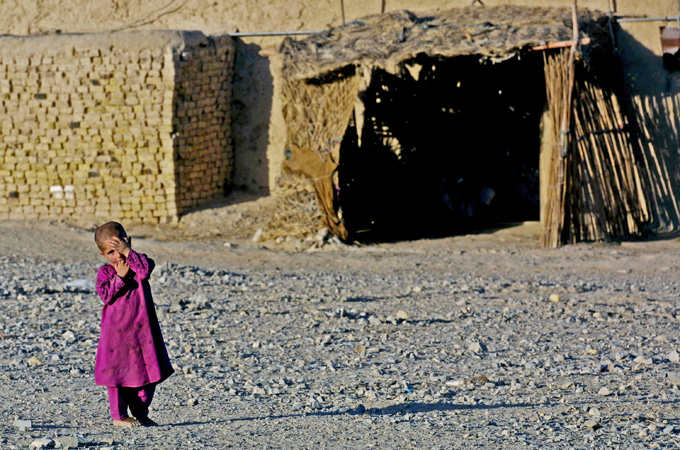The cost of hunger
Today over 7,000 children will die from lack of nutritious food, it is a global pattern among developing countries.

 |
| Since 1990, the world has made ‘dramatic progress in reducing child deaths, cutting the number that die by more than a third since 1990 by investing in vaccines and health workers [GALLO/GETTY] |
Today, more than 7,000 children from all over the world will die for lack of nutritious food. It may not be immediately obvious that this is the cause; a secondary illness, rather than chronic hunger, will likely appear on their death certificates.
Such children might not even look particularly thin; in many cases it is the quality, rather than the quantity, of the food they eat that leaves them dangerously weak. But whatever the straw that breaks the camel’s back, poor nutrition is the underlying cause.
Keep reading
list of 4 itemsFirst pig kidney in a human: Is this the future of transplants?
Why are some countries decriminalising drugs?
‘No good evidence’ for gender care for youth over long-term, review finds
In my job with Save the Children, I see the cost of hunger every day. Last year the crisis that hit my country, Kenya, captured the world’s attention, as television reports showed pitiful pictures of children and adults struggling with severe malnutrition. But even before the drought that triggered the crisis, there was a hidden hunger – and children were dying because of it.
Even on a good year, the poorest families in Kenya can only grow around half of what they need to survive, and with food prices rising, a significant proportion of them cannot afford to buy enough to make up the shortfall. This lack of food leaves them with a weakened immune system, vulnerable to disease and potentially, death.
It is a pattern repeated in developing countries around the world. We know that increasing numbers of families are unable to afford to feed their children properly in the face of rising food prices. Malnutrition lurks in the long shadow of poverty, and as essentials become more expensive around the world, children become increasingly vulnerable.
Even those that survive long bouts of malnutrition will suffer its consequences for the rest of their lives. Some become physically and mentally stunted, unable to keep up at school or find a good job. Others are simply condemned to a lifetime of ill-health and associated poverty. The cost of malnutrition is clear; if it doesn’t take children’s lives, it robs them of their life chances.
This tragic waste of human potential is felt most keenly in the developing world, in the very countries whose future depends on a dynamic youth population.
Good news?
But the news is not all bad. The world has made dramatic progress in reducing child deaths, cutting the number that die by more than a third since 1990 by investing in vaccines and health workers. This investment has saved millions of lives by preventing and treating deadly diseases. Now is the time for the next breakthrough; tackling the scourge of chronic malnutrition.
|
Hunger stalks Niger children |
The solutions are clear, proven and cheap. Making sure babies are breastfed properly and ensuring that children’s foods are fortified with basic vitamins and minerals can have an instant and dramatic impact on their health. Targeting the poorest with special help and ensuring they have access to health-care has equally dramatic positive results.
But none of this will happen on its own. Without the political will to stamp out chronic malnutrition, such knowledge will not benefit those who need it most and the world’s poorest will once again be left behind.
We know what we can do if the momentum is there. The four million children a year whose lives have already been saved by international efforts to stamp out child mortality are living, breathing testament to what can be achieved if the issue is confronted head-on.
But to date, malnutrition has not yet had the same benefit of high-profile campaigning and investment as the other major drivers of child mortality, like HIV/AIDS, lack of access to vaccines and malaria. We cannot allow this imbalance to continue. The time for action has come.
We can stop malnutrition in its tracks. We know what works, and we know how to deliver it. All we are missing is the political will to tackle this silent crisis. If world leaders make a commitment to stamp out hunger in 2012, forcing the issue onto the political agenda, the battle would be half-way won. We know from our previous efforts to stop children dying that every giant leap begins with a small step. We need to take one now.
Assumpta Ndumi is a nutrition expert with years of experience running feeding programmes throughout East Africa, including Darfur, South Sudan and Ethiopia. She has been working with Save the Children for almost a decade and for for the latter half of that has been running hunger programmes in her native Kenya, through many emergencies.
